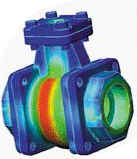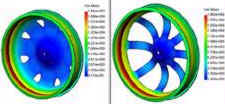|
COSMOS/Edge
offers comprehensive design analysis to users of Unigraphics Solutions'
Solid Edge, in a native Windows, multi-document environment powered by
the Parasolid modeling kernel.
Whether you're an
engineer working in the mechanical, electromechanical, aerospace,
transportation, power, automotive, medical or construction industry, COSMOS/Edge
can help to:
-
Shorten
development time
-
Reduce testing
costs
-
Improve product
quality
-
Increase
profitability
-
Cut time to
market
COSMOS/Edge
introduces a new concept in analysis and design verification to the
engineering community. Ease of use and an intuitive approach to
analyzing complex parts and Assemblies quickly and accurately set COSMOS/Edge
apart from other design programs. An open architecture allows
integration with third party analysis and complementary software, user
customization, and VAR additions.
COSMOS/Edge
is
available in three different bundles - Basic, Intermediate and Advanced
- to give you the analysis tools you need, without forcing you to pay
extra for the ones you donít. For users with more specific engineering
design needs, special add-ons are available.
 Basic
capabilities: Basic
capabilities:
-
Static
Analysis: Computation of stress, strain and displacement results.
Possibility to calculate thermal stresses, with temperature map
obtained from a transient or steady state thermal analysis, or
defined on the model as a boundary condition. Stress stiffening
effect can be taken into account . Contacts between assembly
components are supported (linearized solution).
-
Frequency
Analysis: calculation of natural frequencies and associated mode
shapes. Stress stiffening effect can be taken into account.
-
Buckling
analysis: calculation of buckling mode shapes and associated load
factors. Stress stiffening effect can be taken into account.
-
Thermal
Analysis: computation of heat transfer due to conduction, including
with convection and radiation boundary condition. Transient and
steady state are supported. Outputs include distribution of
temperatures, temperature gradients and heat flux.
Intermediate
and Advanced capabilities (requires SRAC's GEOSTAR):
-
Nonlinear
Structural Analysis :For problems that exhibit geometrical, material
and/or gap/contact nonlinearities, in static or dynamic environment.
Applications include: limit load, post-buckling, plasticity,
rubber-like materials, drop tests, etc.
-
 Advanced
Dynamic Analysis: Dynamic response calculation due to time dependent
or frequency dependent loading. Analysis types include: Advanced
Dynamic Analysis: Dynamic response calculation due to time dependent
or frequency dependent loading. Analysis types include:
-
Modal-time
history analysis
-
Steady-state
harmonic analysis
-
Random
vibration analysis
-
Response
spectra generation and analysis.
-
Fatigue
Analysis: Computation of partial and total fatigue usage factor.
Capability to interface with the modules mentioned above.
-
Electromagnetic
Analysis: Magnetostatic analysis of problems with current sources
and permanent magnets. Electrostatic, current flow and transient
electromagnetic analysis. B-H material curves and/or permanent
magnet demagnetization curves can be taken into account.
-
Computational
Fluid Analysis: Analysis of gases and liquids through a wide range
of Reynolds numbers, for 2D, 3D and axysimetric models. Basic
functionnalities include simulation of internal and external flows
of incompressible, subsonic fluids, with conduction and convection
heat transfer capabilities. Optional additional capabilities such as
compressible gas flows including subsonic, transonic and supersonic
regimes, transient analysis and much more are available. More
information on the COSMOS/FlowPlus page.
-
High Frequency
Electromagnetic Analysis: Suite of 2D and 3D high frequency
electromagnetic field solvers, including a program for the analysis
of resonant structures More information on the COSMOS/HFS Suite page.
visit
the COSMOS/Edge web site
|